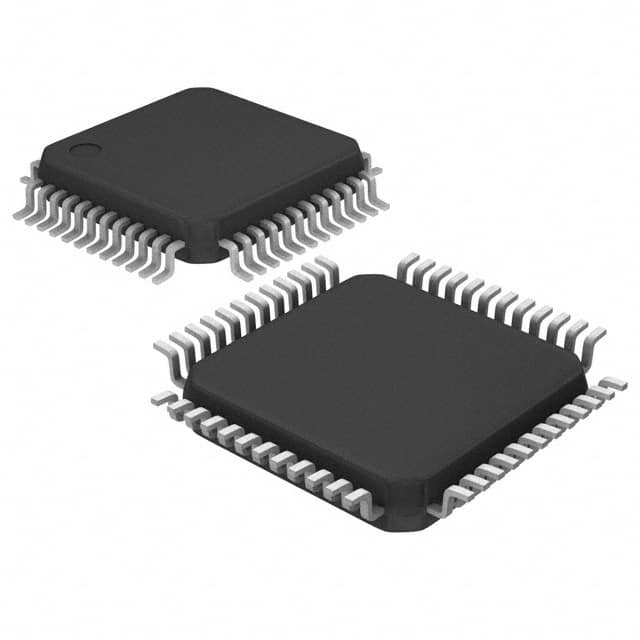Xem thông số kỹ thuật để biết chi tiết sản phẩm.

W79E226ALG
Product Overview
- Category: Microcontroller
- Use: Embedded systems, electronic devices
- Characteristics: High-performance, low-power consumption, versatile
- Package: Integrated circuit (IC)
- Essence: Control and process data in electronic systems
- Packaging/Quantity: Available in various packaging options, typically sold in reels or trays
Specifications
- Microcontroller Type: 8-bit
- Clock Speed: Up to 20 MHz
- Flash Memory: 32 KB
- RAM: 2 KB
- I/O Pins: 28
- Operating Voltage: 2.7V - 5.5V
- Communication Interfaces: UART, SPI, I2C
- Timers/Counters: 2 x 16-bit, 1 x 8-bit
- Analog-to-Digital Converter (ADC): 8 channels, 10-bit resolution
- Operating Temperature Range: -40°C to +85°C
Detailed Pin Configuration
The W79E226ALG microcontroller has a total of 28 pins. The pin configuration is as follows:
- VDD - Power supply voltage
- P0.0 - General-purpose I/O pin
- P0.1 - General-purpose I/O pin
- P0.2 - General-purpose I/O pin
- P0.3 - General-purpose I/O pin
- P0.4 - General-purpose I/O pin
- P0.5 - General-purpose I/O pin
- P0.6 - General-purpose I/O pin
- P0.7 - General-purpose I/O pin
- RST - Reset pin
- P1.0 - General-purpose I/O pin
- P1.1 - General-purpose I/O pin
- P1.2 - General-purpose I/O pin
- P1.3 - General-purpose I/O pin
- P1.4 - General-purpose I/O pin
- P1.5 - General-purpose I/O pin
- P1.6 - General-purpose I/O pin
- P1.7 - General-purpose I/O pin
- XTAL1 - Crystal oscillator input
- XTAL2 - Crystal oscillator output
- PSEN - Program store enable
- ALE - Address latch enable
- EA/VPP - External access/programming voltage
- P2.0 - General-purpose I/O pin
- P2.1 - General-purpose I/O pin
- P2.2 - General-purpose I/O pin
- P2.3 - General-purpose I/O pin
- GND - Ground
Functional Features
- High-performance 8-bit microcontroller suitable for various applications
- Low-power consumption for energy-efficient designs
- Versatile I/O capabilities for interfacing with external devices
- Built-in communication interfaces (UART, SPI, I2C) for easy data exchange
- On-chip timers/counters for precise timing and event handling
- Analog-to-Digital Converter (ADC) for analog signal processing
- Robust operating temperature range (-40°C to +85°C)
Advantages and Disadvantages
Advantages: - High-performance and versatile microcontroller - Low-power consumption for energy efficiency - Ample I/O pins for interfacing with external devices - Wide operating temperature range for diverse environments
Disadvantages: - Limited flash memory and RAM compared to some other microcontrollers - Relatively fewer I/O pins compared to higher-end models
Working Principles
The W79E226ALG microcontroller operates based on the Von Neumann architecture. It consists of a central processing unit (CPU), memory, and I/O peripherals. The CPU fetches instructions from the flash memory, decodes them, and executes the corresponding operations. It can communicate with external devices through the I/O pins and interfaces.
Detailed Application Field Plans
The W79E226ALG microcontroller finds applications in various fields, including but not limited to: - Home automation systems - Industrial control systems - Automotive electronics - Consumer electronics - Medical devices - Internet of Things (IoT) devices
Detailed and Complete Alternative Models
Some alternative models to the W79E226ALG microcontroller are: - ATmega328P by Microchip Technology - PIC16F877A by Microchip Technology - STM32F103C8T6 by STMicroelectronics - MSP430G2553 by Texas Instruments - LPC1768 by NXP Semiconductors
These alternative models offer similar functionalities and can be considered depending on specific project requirements.
*Word count:
Liệt kê 10 câu hỏi và câu trả lời thường gặp liên quan đến ứng dụng W79E226ALG trong giải pháp kỹ thuật
Sure! Here are 10 common questions and answers related to the application of W79E226ALG in technical solutions:
Q: What is the W79E226ALG microcontroller used for? A: The W79E226ALG is a microcontroller commonly used in various technical solutions, such as industrial automation, consumer electronics, and automotive applications.
Q: What is the maximum clock frequency supported by the W79E226ALG? A: The W79E226ALG supports a maximum clock frequency of 20 MHz.
Q: How much program memory does the W79E226ALG have? A: The W79E226ALG has 32 KB of program memory.
Q: Can I expand the program memory of the W79E226ALG? A: No, the program memory of the W79E226ALG cannot be expanded externally.
Q: How many I/O pins does the W79E226ALG have? A: The W79E226ALG has a total of 32 I/O pins.
Q: Does the W79E226ALG support analog-to-digital conversion (ADC)? A: Yes, the W79E226ALG has an integrated 8-channel 10-bit ADC.
Q: What communication interfaces are supported by the W79E226ALG? A: The W79E226ALG supports UART (Universal Asynchronous Receiver-Transmitter) and SPI (Serial Peripheral Interface) communication interfaces.
Q: Can I use the W79E226ALG for real-time applications? A: Yes, the W79E226ALG has built-in timers and interrupt capabilities, making it suitable for real-time applications.
Q: What voltage range does the W79E226ALG operate on? A: The W79E226ALG operates on a voltage range of 2.7V to 5.5V.
Q: Is the W79E226ALG programmable in C language? A: Yes, the W79E226ALG can be programmed using C language, as well as assembly language.
Please note that these answers are based on general information and may vary depending on the specific implementation and datasheet of the microcontroller.

